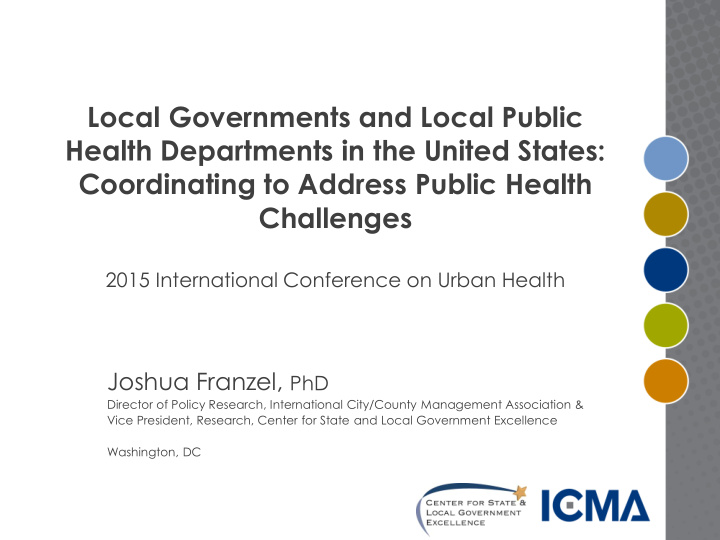



Local Governments and Local Public Health Departments in the United States: Coordinating to Address Public Health Challenges 2015 International Conference on Urban Health Joshua Franzel, PhD Director of Policy Research, International City/County Management Association & Vice President, Research, Center for State and Local Government Excellence Washington, DC
Source: http://www2.census.gov/govs/cog/2012/2012_cog_map.pdf 2
Local public health service provision in the U.S. • Some US states deliver public health services at the state level (~13 states out of 50) • Others have public health services delivered by local / regional public health departments (~19 states) • The rest use a state and local/regional combined approach 3 Sources: Hyde and Shortell ‘The Structure and Organization of Local and State Public Health Agencies in the U.S.’ (2012) ; ASTHO ‘Profile of State Publi c Health’ (2014)
Core U.S. local public health service offerings 50% + of local health departments provide … • disease and environmental health surveillance • immunizations • inspection of food serving establishments and food safety education • inspection of school and related facilities • nutrition services • maternal and child health services • various health screening and treatment programs • vital records • other services Services are often produced through formal and informal networks of governmental, non-profit, and commercial organizations. 4 Source: NACCHO ‘2013 National Profile of Local Health Departments’
General local governments in the U.S. and public health 50%+ of jurisdictions provide… • residential and commercial solid waste collection and disposal • water treatment and distribution • sewage collection and treatment • sanitary inspection • animal control • programs for the elderly • other services Services are often produced through formal and informal networks of governmental, non-profit, and commercial organizations. 5 Source: ICMA ‘Profile of Local Government Service Delivery Choices, 2007’
Current local government and local public health environment in the U.S. • Uneven economic recovery across U.S. • In many cities, traditional revenue sources are not adequate to cover increased service demands • Continued flat or reduced public health expenditures • Many U.S. states encourage their local governments to coordinate more closely using: grant structures; guidelines and procedures; analyses of roles and responsibilities; etc. 6 Sources: Franzel, Newfarmer , Stenberg ‘Collaborative Service Delivery…’ (2013) ICMA Conference; Levi, Segal, St. Laurent, Lang ‘Investing in America’s Health’ (2013)
U.S. local government and public health entity coordination Local governments continue to look for ways to improve coordination… – Administrative • Sharing leadership; finance/accounting; communications; purchasing; facility maintenance; human resources; technology; and grant writing services; among others – Staffing • Sharing health professional positions to recruit and retain needed skill sets in challenging labor markets • 2015: ~30% of public HR professionals report that ‘managing personnel shared across jurisdictions’ is an important/somewhat important issue. – Programs, planning, and infrastructure • Implementing employee and community wellness programs; reducing urban food deserts; developing infrastructure that promotes healthy lifestyles; among others 7 Sources: ICMA/CSPHS ‘Sharing Administrative Services Across Jurisdictions’ (2014); SLGE/UIC ‘Local Health Department Workforc e R ecruitment and Retention’ (2013); SLGE/IPMA-HR/NASPE State and Local Workforce Survey Series (2009-2015)
How U.S. cities prioritized resource allocations in 2014 • Employee Wages • Public Safety • Capital / Infrastructure Development • Employee Pension and Health Benefits • Human Services (24% increased expenditures in 2014) • Contract Services • Education • Other categories 8 Source: NLC ‘City Fiscal Conditions 2014’
Local quality of life, key initiatives of cities, and urban health Key focus areas of city programs and policies: Quality of life components as they relate to local government: Job creation and economic development City services Safe and affordable housing Local environment Environmental stewardship Neighborhood development Education quality and Community performance Local economy Efficient and clean transport infrastructure Virtually all of the components and areas of focus are underpinned by public health efforts : health surveillance; health inspections; nutrition and child health services; water, sewer, and garbage services; etc. 9 Sources: Keir and Faulkner , ‘Considering the Value of Quality of Life Research in Managed Care Medicine’ (2007); Univ. of Oklahoma School of Social Work ‘Quality of Life: A Systems Model’; ICMA research
Thank you. Joshua Franzel , PhD Director of Policy Research, International City/County Management Association & Vice President, Research, Center for State and Local Government Excellence jfranzel@icma.org
Recommend
More recommend